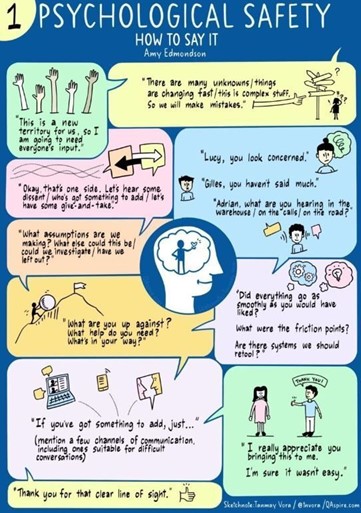Psychological Safety - no darn cuddle fest!
Leila Ljungberg
Psychological Safety - no darn cuddle fest!
Leila Ljungberg
Finding the magical recipe for psychologically safe teams and organizations is something most organizations aspire to, thanks to its many proven effects and benefits. Even though most of our clients are curious to understand more, we (almost) always encounter a few managers who start squirming in their chairs when we talk about psychological safety.
The concern always revolves around similar reasoning: That it’s going to become overly nice here, that it will no longer be okay to set standards, and that no one will “perform” anymore.
Before we delve further into psychological safety, it’s high time we also talk about what it isn’t. No one says it better than The Queen of Psychological Safety herself – Amy Edmondson:
Psychological safety is NOT about:
- Being nice
- Job security
- A guarantee that all ideas will be applauded
- A license to whine
- Freedom from conflict
- Permission to slack off
So, what is psychological safety?
Psychological safety can be simplified as an environment where everyone can express what they think and feel without fear of negative consequences. The effects when successful are numerous, such as increased creativity and efficiency, enhanced learning, more satisfied customers, and satisfied, high-performing employees, to name a few.
For an organization to achieve real success in a world where creativity and innovation are crucial to success, it’s not enough to hire smart and driven employees. Not even the best employees can contribute 100% of what they’re capable of at all critical moments. Sometimes it’s because they don’t realize the need for their knowledge, but more often it’s because they don’t want to stand out, make mistakes, or clash with their boss or colleagues.
For the work to be successful, the workplace must be such that everyone feels they can share their knowledge and ideas. That’s precisely what the concept of psychological safety is all about.
Kindness vs. Performance
If you think about a team where you’ve experienced being your best self, a team where everyone dared to speak their mind – would you then say it was a climate that was kind but without performance? In the examples that pop up in my head, it’s the most high-performing teams that have had the highest psychological safety.
And it hasn’t always been “nice” – quite the opposite, quite a few doses of tough love, you know – tough love. Straightforward feedback but with the best of intentions, focusing on refining and improving the outcome and growing together along the way.

Experiment Your Way Through
To create a psychologically safe environment, it’s crucial how we express ourselves. Like when we have different opinions or need to give feedback. But above all, when we receive a feedback or input from someone who dares to come forward or just takes on another perspective. It’s not always easy, but we must do our best in not punishing or diminishing initiatives like this.
I know it can feel a bit scary and difficult to find new ways to respond and react. But one idea might be to actually give ourselves a dose of psychological safety. What if we, with all the empathy we can muster, try to learn, experiment, and play our way to new ways of interacting with each other?
If we dare to give ourselves space to learn? Can we ask to have a trial conversation and think a little so that it feels safer to try? Can we give ourselves the space to say “I need to think about how to respond a bit.” Or “That was wrong, I’ll try again.”

Think Like a Scientist
Speaking of experimenting – challenge yourself to think like a scientist. The difference between a classic manager and a managerial scientist, according to Amy Edmondson, is that:
- A manager provides answers, while a scientist asks questions
- A manager specifies results, while a scientist shows direction
- A manager supervises and evaluates while a scientist sees opportunities and makes data understandable
- A manager rewards achieved goals while a scientist welcomes mistakes and celebrates discoveries
- And, most importantly – a manager isn’t dependent on psychological safety, but a scientist is.
Because this is the whole key message of psychological safety; to create secure, learning environments where we can perform at our very best, grow together, and become even better! That we perform better is a fantastic thing about psychological safety, but that we enjoy it, learn, become more innovative, and develop is perhaps even more wonderful.
In conclusion, a few more tips on the topic of psychological safety:
- Want to read more about the more scientific definitions of psychological safety? Wikipedia has it.
- Want to watch Amy’s fantastic TED Talk on psychological safety? Click here!
- Want to delve deeper into misunderstandings about psychological safety and the risks associated with it? Click here.
Want to know more about stable vs. fluid teams and psychological safety? Read this article. - Want to be inspired in a lighthearted way by a leader who creates psychological safety? Read Emma’s blog and series recommendations here.
- Want your team/company to get better at psychological safety? Send a love letter here.
Leila Ljungberg